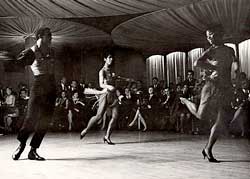10.2.1 The Mambo.

Mambo is a dance musical genre originating in 20th-century Cuban music. Mambo emerged from the Danzón, when Orestes López incorporated a syncopated bass rhythm into the montuno in his Danzón-Mambo, historically known as Danzón de Nuevo Ritmo. Dámaso Pérez Prado later extracted the syncopated rhythm of the montuno from the danzones de nuevo ritmo, thus creating a new Cuban musical genre called Mambo.
Mambo is characterized by a period of silence in each measure, which is why it employs syncopated and off-beat rhythms (shifting the rhythmic accent from the strong beat to the weak beat of the measure). It has a freer, repetitive structure based on sequences. It is performed in a jazz band instrumental format. Its lyrics are not narrative, are generally incoherent, and feature shouts.
The history of mambo begins when Dámaso Pérez Prado began composing music without lyrics around 1940, with the goal of making this type of music more widely accepted by international audiences. In 1946 and 1948, Dámaso recorded his new musical creations with RCA. These were hampered by record producers’ lack of understanding of the music.
For these reasons, in 1948, he traveled to Mexico, where he continued creating and perfecting this new musical rhythm. He managed to premiere the Mambo in a dirty, patched-up circus tent thanks to the support he received from a businessman.
Pérez Prado, along with the incomparable Benny Moré, made mambo a truly popular form of music in Mexico City, but it was from the United States where it spread to the rest of the world, a product of the notable success it achieved there in the mid-1950s. During this decade and the first years of the following decade, this Cuban musical genre enjoyed great popularity in clubs and discotheques throughout the world.
The first Mambo songs were titled Trompetiana (recorded as Mambo) and Panamá (recorded as Mambo kaen). Some of the best-known songs were simply named by number, while others had women’s names or somewhat poetic titles.
Among Pérez Prado’s most popular Mambos we can find “Qué rico mambo” and “Mambo No. 5”.








